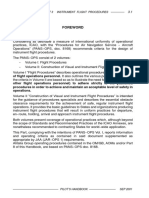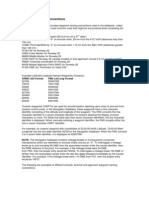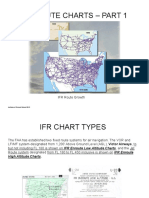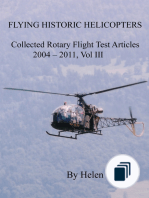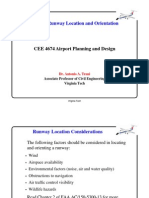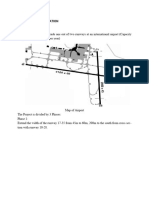Jeppesen Airports Signs PDF
Jeppesen Airports Signs PDF
Uploaded by
NitsugaCopyright:
Available Formats
Jeppesen Airports Signs PDF
Jeppesen Airports Signs PDF
Uploaded by
NitsugaOriginal Title
Copyright
Available Formats
Share this document
Did you find this document useful?
Is this content inappropriate?
Copyright:
Available Formats
Jeppesen Airports Signs PDF
Jeppesen Airports Signs PDF
Uploaded by
NitsugaCopyright:
Available Formats
161
ZUEPFEs¡EN INTRODUCTION 27 FEB04
]CAO RECOMMENDED AIRPORT SIGNS, RUNWAY AND TAXIWAY MARKINGS
MANDATOR.Y INSTRUCTION SIGNS
Application
A mandatory instruct¡on sign identifies a location beyond which an aircraft taxiing shall not proceed unless
authorized by ATC. At uncontrolled a¡rports, use appropriate precautions prior to proceeding. Mandatory
instruction signs may include runway designation signs, category l, ¡l or lll holding position signs, runway-
hoiding postion signs and NIO ENTRY signs. Runway-holding position mark¡ngs are supplemented at a
taxiway/runway or a runway/runway intersection with a runway designat¡on sign. A runway designation s¡gn at
a taxiway/runway intersection or a runway/runway intersection will be supplemented with a location sign ¡n the
outboard (farthest from the taxiway) position, as appropriate. A NO ENTRY sign is prov¡ded when entry into an
area is prohib¡ted.
Location
A runway designat¡on sign at a tax¡way/runway intersection or a runway/runway intersection will be located on
each side of the runway-hold¡ng position marking fac¡ng into the d¡rection of approach to the runway. A
category l, ll or lll holding position sign will be located on each side of the runway-holding position marking
facing into the direction of the approach to the critical area. A runway-holding position sign will be located on
each s¡de of the runway-holding position facing the approach to the obstacle limitation surface or ILS/MLS
critical/sensitive area, as appropriate.
Characteristics
Mandatory instruct¡on signs have a red background, w¡th white inscriptions. The inscriptions on a runway
designation sign will consist of the runway des¡gnat¡ons of the intersecting runway properly oriented to the
v¡ewing direction. The inscriptions on a category l, ll or lll or joint ll/lll holding posit¡on sign will consist of the
runway designatorfollowed by CAT l, CAT ll or CAT lll as appropriate. The ¡nscr¡ptions on a runway-holding
pos¡tion sign will consist of the taxiway des¡gnation and a number.
WMffi
rrTrfff,nil m
@
Ftriltfin
LOCAÍOMUNWAYDESgMNON
E g
m
RUNWAY4OLDIM PGNON
CATEOORY N HOLDING rcsNON
IOCATION/RUÑWAY DESICNATION
O JEPPESEN SANOERSON, INC,, 2004. ALL RIGHTS RESERVED
't62 27 FEB 04 INTRODUCTION Zl¡eepeseru
ICAO RHCOMMEI'üDED AIRPORT SIGNS, RUNWAYAND TAXIWAY MARKINGS
INFORMATION S¡GNS
Application
An ¡nformation s¡gn identifies a spec¡fic iocation or rout¡ng. lnformation signs include: direction, location,
dest¡nation, runway ex¡t and runway vacated signs. A runway exit s¡gn is prov¡ded to identify a runway exit. A
runway vacated s¡gn is provided where the exit taxiway has no centerline lights and there is a need to indicate
leaving the runway, the ILSiMLS crit¡calisensit¡ve area. A dest¡nation sign ¡ndicates the direction to a specific
destination, such as cargo, general aviation, etc. A combined location and direction sign indicates routing
information prior to a taxiway intersection. A direction sign identifies the designation and direction at a taxiway
intersection. A location sign is prov¡ded in conjunct¡on w¡th a runway des¡gnation sign except at a
runway/runway intersection.
Locat¡on
lnformai¡on signs are located on the left-hand s¡de of the taxiway in line with the taxiway intersection marking.
Where there is no taxiway intersect¡on marking the sign is installed at least 40m away from the centerline of the
intersecting taxiway. A runway ex¡t sign is located on the same side of the runway as the exil is located (i.e. left
or right). A runway vacated s¡gn is located at least on one side of the taxiway.
Characteristics
An inforrnation sign other than a locatjon sign consists of an ¡nscr¡ption in black on a yellow background. A
location sign cons¡sts of an inscription in yellow on a black background. A runway exit sjgn consists ofthe ex¡t
tax¡way designator and an arrow ¡ndicating the direction to follow. A runway vacated sign depicts the runway-
holding position marking as shown ¡n the example in Pattern A in the example under "Runway-Holding Position
Markings". The inscriptions on a dest¡nat¡on sign comprise an alpha, alphanumerical or numer¡cal message
ident¡fying the destination plus an arrow ind¡cating the direction to proceed. The inscriptions on a direction sign
comprise an alpha, alphanumerical message ident¡fying the taxiway(s) plus an arrow or arrows appropriately
oriented as shown in the example. The inscriptions on a location sign comprise the dest¡nation of the locat¡on
taxiway, runway or other pavement the aircraft is on or ¡s entering.
Note: Generally, signs should be lighted if the runway or taxiway on which they are installed is lighted.
LEFT SIDE RIGHT SIDE
€-CBC+
DIRECTION/LOCATION/DIRECTION
ffic-l
LOCATIONiOIRECTION
é- APRON
DESTINATION
trsl [@E|r.zZ
RUNWAY EXIT RUNWAY EXIT
DIRECTION/DIRECTION/OIRECTION/LOCATION/DIRECTION/DIRECTION/DIRECTION
<- 2500 m 2500 m +
INTERSECTION TAKE.OFF
G) JEPPESEN SANDERSON, INC., 2004. ALL RIGHTS RESERVED,
ZlJEFPESEN INTRODUCTION 27 FEB 04 163
ICAO RECOMMENDED AIRPORT SIGNS, RUNWAY AND TAXIWAY MARKINGS
MANDATOR,Y INSTRUCTION MARKINGS
Application
Where it is impracticable to install a mandatory instruction sign a mandatory instruction marking is provided on
the surface of the pavement. Where operationally required, such as on taxiways exceed¡ng 60m in w¡dth, a
mandatory instruction sign may be supplemented by a mandatory instruct¡on marking.
Location
The mandatory instruction marking is located on the left-hand side of the taxiway center l¡ne marking on the
holding side of the runway-holding position marking.
! Characterist¡cs
Mandatory instruction mark¡ngs consist of an inscription in white on a red background. Except for a NO ENTRY
marking, the inscript¡on provides information identical to that of the associated mandatory instruction sign. A
NO ENTRY marking consists of an inscription in white reading NO ENTRY on a red background.
O JEPPESEN SANDERSON. INC.. 2004. ALL RIGHTS RESERVED
164 27 FEB 04 INTRODUCTION ZlJEFPEsEN
ICAO RECOMMENDED AIRPORT SIGNS, RUNWAY AND TAXIWAY MARKINGS
RUNWAY-HOLDING POSITION MARKINGS
Applicat¡on and Location
Runway-holding position markings are Iocated at runway holdlng positions.
Characteristics
At an intersect¡on of a taxiway and a non-precision, non-instrument or take-off runway or where a single
runway-hold¡ng position ¡s provided at an intersect¡on of a taxiway and a precision approach category l, ll, or lll
runway, the runway-holding position marking will be as shown as in pattern A. Where two or three runway-
holding positions are provided at such an intersection, the runway-holding position marking closer to the
runway will be as shown as in pattern A, and the markings farther from the runway as in pattern B. Where a
pattern B runway-holding pos¡tion marking exceeds 60m in length, the term CAT ll or CAT lll as appropriate will
be marked on the surface at the ends of the runway-holding position marking. The runway-holding position
marking displayed at a runway/runway intersection will be perpendicular to the centerline of the runway forming
part of the standard taxiroute. The runway-holding position marking will be shown as in pattern B.
Pattern A Pattern B
INTERMEDIATE HOLDING POSITION MARKINGS
Application and Locat¡on
An intermediate holding pos¡tion mark¡ng ¡s displayed at an intersect¡on of two paved tax¡ways. lt is positioned
across the taxiway coincident w¡th a stop bar or intermediate holding position lights, where provided.
Characteristics
An ¡ntermed¡ate holding posit¡on marking cons¡sts of a single broken yellow l¡ne.
O JEPPESEN SANDERSON, INC., 2004. ALL RIGHTS RESERVED
Z!-¡ee¡¡esEt\¡ gooecos INTRODUCTION 165
ICAO RECOMMENDED AIRPORT SIGNS, RUNWAY AND TAXIWAY MARKINGS
STOP BARS
APPLICATION
A stop bar is provided at every runway-holding pos¡-
tion when it is intended that the runway will be used
in RVR conditions less than 350m or between 350m
and 550m. A stop bar will be provided at an ¡nterme-
diate hold¡ng position to supplement markings with
l¡ghts or where normal stop bar lights might be ob-
scured.
{
LOCATION
Configuratioñ A
Stop bars are located across the taxiway at the polnt
where ¡t is desired that traffic stop. Additional lights
may be provided at the taxiway edge.
CHARACTERISTICS
Stop bars consist of lights spaced at ¡ntervals across
the taxiway, showing red in the intended direction of
approach to the intersection or runway-holding posi-
tion. Stop bars installed at a runway-holding position
will be unid¡rectional, showing red in the direction of
approach to the runway.
RUNWAY GUARD LIGHTS
Configuration B
APPLICATION
Runway guard lights, configurat¡on A, are located at
each taxiway/runway intersection associated with a
runway ¡ntended for use in:
RVR conditions less than 550m where a stop bar ¡s
RUNWAY MARKINGS
not installed; and
RVR conditions between 550m and 1200m where Runway markings are white.
traffic density is medium or low.
Configurat¡on A or B or both will be provided at each
taxiway/runway intersection where the configurat¡on
of the intersection needs to be enhanced, such as
on a wide throat taxiway.
LOCATION
Runway guard lights, configuration A, are located at
each side of a taxiway, whereas in configuration B
they are located across the taxiway.
CHARACTERISTICS
Runway guard lights are unidirectional flashing yel-
low l¡ghts.
O JEPPESEN SANDERSON. INC. 2004. 2005. ALL FIGHTS RESERVED
166 INTRODUCTION 30 DEc05 fi!-reeeesent
ICAO RECOMMENDED AIRPORT SIGNS, RUNWAY AND TAXIWAY MARKINGS
THRESHOLD MARKINGS RUNWAY CENTERLINE MARKINGS
APPLICATION AND LOCATION APPLICATION AND LOCATION
Threshold markings are prov¡ded at the threshold of A runway centerline marking is provided on a paved
a paved instrumenl and non-inslrumenl runway in- runway along the centerline.
tended for use by ¡nternational commercial ajr trans-
port.
CHARACTERISTICS
CHARACTERISTICS Runway centerline markings consist of a line of uni-
formly spaced stripes and gaps. Stripes a¡e normal-
Runway threshold mark¡ngs consist of a pattern of ly 30m long, gaps 20m long.
long¡tud¡nal stripes of uniform dimensions disposed
symmetrically about the centerline of a runway. The
number of stripes shall be in accordance with the HIGH SPEED TAXIWAY TURN-OFF
runway width as follows: TNDTCATOR LIGHTS (HSTTL)
RUNWAY WIDTH NUMBER OF ICAO term is Rapid Exit Taxiway lndicator L¡ghts
STRIPES (RErL)
tlm ¡."¡a t 4 APPLICATION
23m W' 6 HSTIL should be provrded on a runway intended for
use in RVR conditions less than 350m and/or where
30m ¡On I 8 traffic densily ¡s heavy.
45rI'
l7ol 12
LOCATION
6om {916' '16
A set of HSTIL shall be located on the runway on the
same side of the runway centerline as the associat-
Where a runway des¡gnator is placed within a ed high speed turn-off taxiway, ¡n lhe configuration
threshold marking, there will be a minirnum of lhree shown below.
str¡pes on each s¡de of the runway centerline.
Stripes are at least 30m long.
CHARACTERISTICS
RUNWAY DESIGNATION MARKINGS HSTIL are fixed un¡directional yellow l¡ghts, aligned
so as to be v¡sible to the pilot of a landing airplane in
the direct¡on of approach to the runway.
APPLICATION AND LOCATION
Runway designat¡on markings are located at the
thresholds of a paved runway.
CHARACTERISTICS
Runway designation markings consists of a two-digit
number located at the threshold. On parallei run-
ways each runway designation number is supple-
mented by a letler in the order from left to right when
viewed from the direction of approach.
Point of
tangency
oooooo ooo oooooooo ort, o ¡
RETILS
2m lateral
spacing
@JEPPESEN SANDERSON, INC.2OO5. ALL RIGHTS RESERVED
ZUEPFEsEN INTRODUCTION 27 FÉB 04 167
ICAO RECOMMENDED AIRPORT SIGNS, RUNWAY AND TAXIWAY MARKINGS
RUNWAY TOUCHDOWN ZONE MARKINGS
Appl¡cation
A touchdown zone marking is provided in the touchdown zone of a paved precision approach runway and and
non-precision approach runway or non-instrument runway where additional identification of the touchdown
zone is required.
Location and Character¡st¡cs
A touchdown zone marking shall consist of pairs of rectangular markings symmetr¡cally d¡sposed about the
runway centerline with the number of pairs related to the landing distance available (LDA).
g A touchdown zone marking shall conform to either of the two runway patterns shown below.
LDA oT DISTANCE BETWEEN THRESHOLDS PAIR(S) of MARKINGS
Less than 900m
Less than I 200m but not less than 900m 2
I ess then I 500m but not less than
1 200m
Less than 2400m but not less than I 500m 4
2400m or more b
RUNWAY AIMING POINT MARKINGS
Application
An aiming point marking will be prov¡ded at each approach end of a paved instrument or non-instrument
runway.
Locat¡on and Character¡stics
An aiming point marking consists of two conspicuous stripes in conformity with the dimensions shown for the
runway patterns ¡n the example shown under "Runway Touchdown Zone and Aim¡ng Point Markings".
@ JEPPESEN SANDERSON, INC., 2004. ALL RIGHfS RESERVED
168 27 FEB 04 INTRODUCTION luEf¡f¡E5EN
ICAO RECOMMENDED AIRPORT SIGNS, RUNWAY AND TAXIWAY MARKINGS
RUNWAY TOUCHDOWN ZONE AND AIMING POINT MARKINGS
(continued)
TOUCHDOWN
ZONE
150m MARKINGS l50m
(492',l. (492'\
'150m '150m
(492') (492',)
IMING POINT
MARKINGS
30m (98') to
60m ( 197')
300m by
(984',) 4m (13') to
10m (33')
150m
(492',\ 400m
( 1312', )
18m (59') to
400m 22.5m (74'\
(1312'\ 18m (59') to
22.5m (7 4' \
STRIPES -
1.8m (6') WIDTH
RUNWAY
1.5m (5') SPACING SIDE
22.5m (74') MIM
STR¡PE
LENGTH MARKINGS
150m 150m
(452',) (4s2'\ z,t
L
ililil1il1 ililililt
@ JEPPESEN SANDERSON, INC., 2004. ALL R¡GHTS RESERVED
ZIJEPPESEN INTRODUCTION 27 FEB 04 169
ICAO RECOMMENDED AIRPORT SIGNS, RUNWAY AND TAXIWAY MARKI,NGS
RUNWAY SIDE STRIPE MARKING
Appl¡cation
Runway side stripe mark¡ngs are prov¡ded between the thresholds of a paved runway where there is lack of
contrast between the runway edges and the shoulders. Runway side stripe markings are provided on precision
approach runways.
Location and Characteristics
Runway side stripe markings consist of two stripes, one placed along each edge of the runway no more than
30m from the runway centerl¡ne regardless of the runway width.
DISPLACED THRESHOLD MARKINGS
Temporar i ly
Oisplaced
Thres ho I d
Transverse
Str i pe
Displaced
Threshold
TEMPORARILY DISPLACED TEMPORARILY OR PERMANENTLY
THRESHOLD DISPLACED THRESHOLD
CLOSED RUNWAYS, TAXIWAYS OR PARTS THEREOF
Application and Location
A closed marking will be d¡splayed at each end of a runway or portion thereof, declared permanently closed to
use by all aircraft. Additionally, markings are placed so that the maximum ¡nterval between the markings does
not exceed 300m. On a tax¡way, a closed marking shall be placed at least at each end of a taxiway or portion
thereofthat is closed.
Characteristics
The closed marking is shaped l¡ke a cross. The marking is white when displayed oR a runway and yellow when
displayed on a taxiway.
NON LOAD-BEARING SURFACES
The boundary between load-bearing surfaces and non load-bearing surfaces, such as shoulders for taxiways,
holding bays, aprons and other non load-bearing surfaces which, if used, might result in damage to the aircraft
are indicated by a taxi side stripe. This marking consists of a pa¡r of solid lines the same color as the taxiway
centerline marking.
@ JEPPESEN SANDERSON. INC. 2004. ALLRIGHTS RESERVEO,
27 FEB 04 INTRODUCTION
|OAO RECOMMENDED AIRFORT SIGNS;:RUNWAY AND TAXIWAY MARKINGS 'UEFPESEN
PRE.THRESHOLD AREA MARKING (CHEVRON MARKING)
Vvhen the paved surface pr¡or to the threshold exceeds 60m in length and is not suitable for use by aircraft, the
ent¡re length will be rnarked with a chevron rnarking (preferably yellow) pointing in the d¡rection of the runway
threshold.
THRESHOLD
END OF ICAO RECOMMENDED AIRPORT SIGNS, RUNWAY AND TAXIWAY MARKINGS
@ JEPPESEN SANDERSON, INC., 2004. ALL RIGHTS RESERVED,
You might also like
- Cessna Citation Bravo Flight Safety Training ManualDocument270 pagesCessna Citation Bravo Flight Safety Training ManualNitsuga97% (29)
- Pages From PFM VFR Communication TipDocument10 pagesPages From PFM VFR Communication TipDawitNo ratings yet
- OMDBDocument65 pagesOMDBMahmoud HefnyNo ratings yet
- OEJNDocument90 pagesOEJNMahmoud HefnyNo ratings yet
- Amsterdam, NetherlandsDocument149 pagesAmsterdam, NetherlandspatrouilledeafranceNo ratings yet
- LTACDocument64 pagesLTACİ. Çağlar YILDIRIM100% (1)
- Algeria Jeppesen ChartsDocument115 pagesAlgeria Jeppesen ChartsAbidou TobniNo ratings yet
- A330 ManualDocument642 pagesA330 ManualMcNo ratings yet
- LIPZDocument32 pagesLIPZWael ChebliNo ratings yet
- FAGCDocument6 pagesFAGCAnas SayedNo ratings yet
- Simcheck Airbus A300B4-200: Carousel Iv InsDocument16 pagesSimcheck Airbus A300B4-200: Carousel Iv InsAviasoft IndoNo ratings yet
- EBBRDocument137 pagesEBBRHani BoudiafNo ratings yet
- Extract of EAIP VABB AD 2.22Document5 pagesExtract of EAIP VABB AD 2.22Vikram DograNo ratings yet
- Dtnh/Nbe: Enfidha, TunisiaDocument18 pagesDtnh/Nbe: Enfidha, TunisiaTweed3ANo ratings yet
- Cessna 550-551-560 (PWC JT15D) Initial Aircraft Type Rating CourseDocument27 pagesCessna 550-551-560 (PWC JT15D) Initial Aircraft Type Rating CourseNitsuga50% (2)
- Airport MarkingsDocument32 pagesAirport MarkingsMD WAHID ANSARINo ratings yet
- Jeppview For Windows: List of Pages in This Trip KitDocument39 pagesJeppview For Windows: List of Pages in This Trip KitPIETRONo ratings yet
- Jeppview For Windows: List of Pages in This Trip KitDocument50 pagesJeppview For Windows: List of Pages in This Trip KitМистермарк МистерклимюкNo ratings yet
- Eawm PacificDocument2,095 pagesEawm PacificGeorge ChiotisNo ratings yet
- EGGPDocument10 pagesEGGPIludiran KolaNo ratings yet
- LIMLDocument16 pagesLIMLArduino RocciolettiNo ratings yet
- KJACDocument29 pagesKJACzacklawsNo ratings yet
- Jeppview For Windows: List of Pages in This Trip KitDocument49 pagesJeppview For Windows: List of Pages in This Trip KitAron DiofasiNo ratings yet
- EGKK ParkingDocument1 pageEGKK ParkingDannyinnitNo ratings yet
- FIMPDocument28 pagesFIMPBertrandNo ratings yet
- OTHHDocument60 pagesOTHHMahmoud HefnyNo ratings yet
- 8260.3B - U.S TerpsDocument436 pages8260.3B - U.S TerpsSergio GuevaraNo ratings yet
- VFR & IFR Aeronautical Chart & SymbolsDocument51 pagesVFR & IFR Aeronautical Chart & SymbolsEndro RastadiNo ratings yet
- How To Navigate Using A VOR - 9 Steps (With Pictures) - WikihowDocument4 pagesHow To Navigate Using A VOR - 9 Steps (With Pictures) - WikihowabuntsogNo ratings yet
- Voci IapDocument15 pagesVoci IapParvesh GautamNo ratings yet
- Fimp PDFDocument35 pagesFimp PDFmitulNo ratings yet
- VTBSDocument51 pagesVTBSPaperFishNo ratings yet
- Navigational AidsDocument69 pagesNavigational AidsChouaib Ben BoubakerNo ratings yet
- Ltai 17-2020 PDFDocument113 pagesLtai 17-2020 PDFTweed3A100% (1)
- Ankara, Turkey Ltac/Esb: 1.1. Atis 1.2. Preferential Rwy System Operations 1. GeneralDocument59 pagesAnkara, Turkey Ltac/Esb: 1.1. Atis 1.2. Preferential Rwy System Operations 1. GeneralTweed3ANo ratings yet
- Lpma RNP Z 05Document1 pageLpma RNP Z 05Álvaro NetoNo ratings yet
- 10-Ifr Enroute ChartsDocument11 pages10-Ifr Enroute ChartsAlejandro PattNo ratings yet
- Fabl - Aerodrome Chart - Ad-01Document1 pageFabl - Aerodrome Chart - Ad-01KHUSHAL BANSALNo ratings yet
- Inflight EntertainmentDocument10 pagesInflight EntertainmentNeha BhatiaNo ratings yet
- Lirf JeppesenDocument107 pagesLirf JeppesenJP ZemogNo ratings yet
- Q CodesDocument14 pagesQ CodesWIN MIN100% (1)
- Dubrovnik, Croatia Lddu/Dbv: 1.1. Atis 1.2. Noise Abatement Procedures 1. GeneralDocument25 pagesDubrovnik, Croatia Lddu/Dbv: 1.1. Atis 1.2. Noise Abatement Procedures 1. GeneralTweed3ANo ratings yet
- Text Instrument Flight ProceduresDocument56 pagesText Instrument Flight ProceduresGuilioNo ratings yet
- Way Point Naming ConventionsDocument2 pagesWay Point Naming ConventionsMatias GuajardoNo ratings yet
- Ltay DenizliDocument27 pagesLtay DenizliM. Akif BALAYNo ratings yet
- LGAV - AthenesDocument35 pagesLGAV - AthenesjilfNo ratings yet
- Iefing. 1. General 1.1. ATIS: 10-1P SchwechatDocument54 pagesIefing. 1. General 1.1. ATIS: 10-1P SchwechatbakteroNo ratings yet
- IFR Clearance - (Forge Flight Simulation)Document2 pagesIFR Clearance - (Forge Flight Simulation)Raph 1123No ratings yet
- Hadr/Dir Dire Dawa, EthiopiaDocument6 pagesHadr/Dir Dire Dawa, EthiopiaAbdulfetah Nesredin100% (1)
- Climb Via Descend Via Speed AdjustmentsDocument95 pagesClimb Via Descend Via Speed AdjustmentsIvanna JimenezNo ratings yet
- OMDBDocument61 pagesOMDBrezarachmatNo ratings yet
- LTAIDocument115 pagesLTAIKAPTAN X100% (1)
- List of Type Design Accepted by DGCA: (From April 2004 To 30 September 2020)Document2 pagesList of Type Design Accepted by DGCA: (From April 2004 To 30 September 2020)ShivamSrivastavaNo ratings yet
- IR Classes 5Document2 pagesIR Classes 5Ingrid SavellanoNo ratings yet
- Enroute Charts - Part 1: IFR Route GrowthDocument21 pagesEnroute Charts - Part 1: IFR Route GrowthFrederick OteikwuNo ratings yet
- Jeppview For Windows: List of Pages in This Trip KitDocument39 pagesJeppview For Windows: List of Pages in This Trip KitCharles CitronNo ratings yet
- Rpui AipDocument3 pagesRpui AipL LNo ratings yet
- Jeppview For Windows: General Information General InformationDocument49 pagesJeppview For Windows: General Information General InformationLiviu 22No ratings yet
- Cessna 172 CheckoutDocument9 pagesCessna 172 CheckoutLuminita SaiuNo ratings yet
- Missed Approach to Death: A Missed Approach Aborted, and Where It LeadsFrom EverandMissed Approach to Death: A Missed Approach Aborted, and Where It LeadsNo ratings yet
- Climate Change and Aviation PDFDocument409 pagesClimate Change and Aviation PDFNitsugaNo ratings yet
- WordPress Basics, A Step by Step Guide For Beginners PDFDocument232 pagesWordPress Basics, A Step by Step Guide For Beginners PDFNitsuga100% (1)
- King Air E90 PropellerDocument17 pagesKing Air E90 PropellerNitsugaNo ratings yet
- Thrust Flight PA44 Study GuideDocument28 pagesThrust Flight PA44 Study GuideNitsugaNo ratings yet
- High Lift DevicesDocument33 pagesHigh Lift DevicesNitsugaNo ratings yet
- Global Training Manual - Part1Document124 pagesGlobal Training Manual - Part1Nitsuga100% (1)
- Electronica PracticaDocument197 pagesElectronica PracticaNitsuga100% (2)
- Cat I. II. III OperationsDocument31 pagesCat I. II. III OperationsNitsuga100% (1)
- Codes For HomeownersDocument521 pagesCodes For HomeownersNitsuga100% (2)
- Wahp - Jenderal Besar SoedirmanDocument7 pagesWahp - Jenderal Besar SoedirmanAbang FayyadNo ratings yet
- Task C - Airport Runway and Taxiway Signs Markings and LightingDocument7 pagesTask C - Airport Runway and Taxiway Signs Markings and Lightingاحمد عبدNo ratings yet
- ABT BoosterDocument8 pagesABT Boosterramesh sitaulaNo ratings yet
- Flylight Agl 2023Document54 pagesFlylight Agl 2023XIAOYANG SHENo ratings yet
- VFR Flight BriefingDocument6 pagesVFR Flight BriefingAhmed HassanNo ratings yet
- AIP Belgaum Airport, IndiaDocument16 pagesAIP Belgaum Airport, Indiass khadriNo ratings yet
- Braking Action 0.25 - Google SearchDocument1 pageBraking Action 0.25 - Google SearchReggie JoshuaNo ratings yet
- Authority To Drive Airside (Ada) : Theory TestDocument6 pagesAuthority To Drive Airside (Ada) : Theory TestAbdul RazackNo ratings yet
- Runway OrientationDocument24 pagesRunway OrientationAbdulkareem Adeyinka100% (2)
- Wind Criteria Due To Obstacles at and Around Airports: Executive SummaryDocument202 pagesWind Criteria Due To Obstacles at and Around Airports: Executive SummarywilmerNo ratings yet
- Cap 168Document392 pagesCap 168Ray KilpatrickNo ratings yet
- Informative Speech Outline TemplateDocument3 pagesInformative Speech Outline TemplateballhuntNo ratings yet
- Seminar Report On: Design of Modern AirportsDocument24 pagesSeminar Report On: Design of Modern AirportsRishabh PariharNo ratings yet
- EBOS (Oostende Airport)Document55 pagesEBOS (Oostende Airport)Roshan UppalNo ratings yet
- Capaldo ICTTS 2000 02Document9 pagesCapaldo ICTTS 2000 02amansax77No ratings yet
- FCOM07-02.full Operational Landing Data OLDDocument14 pagesFCOM07-02.full Operational Landing Data OLDCLDriverNo ratings yet
- Airport EngineeringDocument75 pagesAirport EngineeringCivil Tata67% (3)
- 20121116-0 - A30B - EI-EAC Lateral Runway Excursion During Landing RollDocument9 pages20121116-0 - A30B - EI-EAC Lateral Runway Excursion During Landing RollMd NoMaN OmErNo ratings yet
- Physical Characteristics: Nov 23, 2021 ICAO Annex 14 Training Course 1Document74 pagesPhysical Characteristics: Nov 23, 2021 ICAO Annex 14 Training Course 1ho kong hon100% (1)
- Eggd ParkingDocument1 pageEggd ParkingJoel AmparoNo ratings yet
- Apm E175 PDFDocument130 pagesApm E175 PDFWesley St GeorgeNo ratings yet
- HIRA ExerciseDocument7 pagesHIRA ExerciseTrầnNgọcPhươngThảoNo ratings yet
- Transmission TestDocument15 pagesTransmission TestvinayNo ratings yet
- FPPDocument5 pagesFPPSteven PaulNo ratings yet
- Ltaz - Kapadokya (Aip Turkey)Document11 pagesLtaz - Kapadokya (Aip Turkey)Sinan ÖzNo ratings yet
- Modificaciones Al Anexo 14 PDFDocument19 pagesModificaciones Al Anexo 14 PDFGerman VasenNo ratings yet
- Guide To Airplane LightsDocument19 pagesGuide To Airplane LightsMelanie MartinssonNo ratings yet
- Global Reporting Format: AIS Aspects (SNOWTAM)Document19 pagesGlobal Reporting Format: AIS Aspects (SNOWTAM)Elsad SadiqovNo ratings yet











































